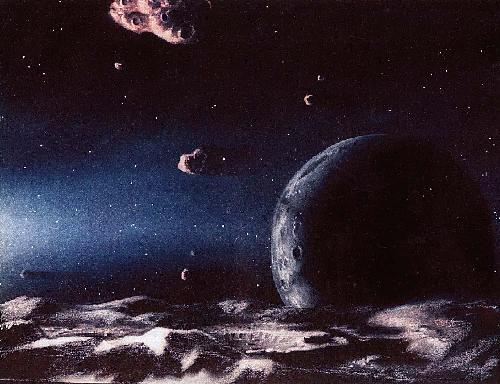| LIKE A BAT OUT OF HELL: INTERSTELLAR INTERLOPER 1I/2017 U1 |
|---|
Astrophysical Journal Letters, 850:L36 (2017 December 1)
Ap. J. paper | NOAO Release | Griffith Talk | Asteroid Day Video | Comet Home Page | Kuiper Belt Home Page |
Summary
We present observations of the interstellar interloper 1I/2017 U1
('Oumuamua) taken during its 2017 October flyby of Earth. The optical
colors B-V = 0.70+/-0.06, V-R = 0.45+/-0.05, overlap those of the
D-type Jovian Trojan asteroids and are incompatible with the ultrared
objects which are abundant in the Kuiper belt. With a mean absolute
magnitude H_V = 22.95 and assuming a geometric albedo p_V = 0.1,
we find an average radius of 55 m.
No coma is apparent; we deduce a limit to the dust mass production rate
of only 2e-4 kg/s, ruling out the existence
of exposed ice covering more than a few m^2 of the surface.
Volatiles in this body, if they exist, must lie beneath an involatile
surface mantle ~0.5 m thick, perhaps a product of prolonged
cosmic ray processing in the interstellar medium. The lightcurve
range is unusually large at 2.0+/-0.2 magnitudes. Interpreted
as a rotational lightcurve the body has semi-axes ~230 m x
35 m. A 6:1 axis ratio is extreme relative to most small solar
system asteroids and suggests that albedo variations may additionally
contribute to the variability. The lightcurve is consistent with a
two-peaked period ~8.26 hr but the period is non-unique as a
result of aliasing in the data. Except for its unusually elongated
shape, 1I/2017 U1 is a physically unremarkable, sub-kilometer, slightly
red, rotating object from another planetary system. The steady-state
population of similar, 100 m scale interstellar objects inside
the orbit of Neptune is ~10,000, each with a residence time ~10 yr.
Caption: (left) Interstellar object 1I/2017 U1 imaged from the Nordic Optical Telescope in Las Palma on UT 2017 October 26, the day after the object was announced. The top image shows the average of 12 separate integrations taken with the telescope tracked to follow the object. The bottom object shows the median of the same images, in which the trailed field objects are largely suppressed.
(middle) Animation showing the path of U1 through the solar system, courtesy of NASA.
(right) Artist's impression of U1 seen close-up. Image credit: ESO/M. Kornmesser.
Click on the images to see larger versions.
U1 is a 100 m scale solid object ejected from orbit around another star. It could be billions of years older than the Sun.
The second interstellar object is 2019Q4 (Borisov).
Images from the paper: Figure 1 Figure 2 Figure 3 Figure 4 Figure 5 Figure 6 Figure 7
Ap. J. paper | NOAO Release | Public Talk | Asteroid Day Vid (66Mb mp4) | Comet Home Page | Kuiper Belt Home Page |
David Jewitt
 |
 |
|
| Comet | Jewitt | Kuiper |
|---|